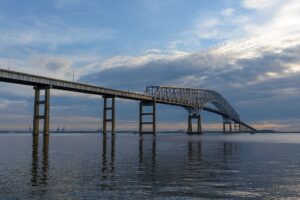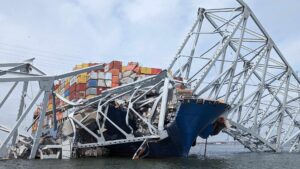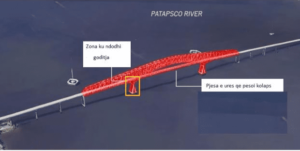NIKOLLA NIKA
Department of Construction Engineerin
On March 26, 2024, the cargo ship “Dali” struck the pier and caused the collapse of the Francis Scott Key Bridge over the navigable Patapsco River in Baltimore, USA.
The bridge, constructed in 1977, had a length of 1.6 miles. The central portion that collapsed was 366 meters long. This section of the bridge was designed as a continuous steel structure, supported by two main piers in the shape of the letter “A,” made of reinforced concrete. Additionally, there were two lateral piers where the steel portion of the bridge connected to the rest of the structure, consisting of reinforced concrete columns.

Fig 1. Pamje e urës më 2015 https://en.wikipedia.org/wiki/Francis_Scott_Key_Bridge_collapse
The structure was realized in the form of a continuous steel truss, where in the middle space, it created a arch-type truss from which suspended bridge hangers hung to support the roadbed. The bridge, with its presentation and structural solution, as they say, constituted an “icon” of structural models. The steel truss, with its variable height, evoked the American tradition of bridge construction at the end of the 19th century and the first half of the 20th century. Within a bridge project, various structural elements were interwoven. Its appearance sparked and set in motion engineering thought to dissect and interpret all its constructive characteristics.

Hydrographic Survey Vessel CATLETT observe the damage resulting from the collapse of the Francis Scott Key Bridge in Baltimore, March 26, 2024. In accordance with USACE’s federal authorities, USACE will lead the effort to clear the channel as part of the larger interagency recovery effort to restore operations at the Port of Baltimore.[/caption]
However, on the night of March 26, a collision with a cargo ship at its base was enough to destroy the entire central steel zone of the bridge. How is this explained?
We don’t have the the project and the calculations of the bridge, and even the kinetic data of the impact (the mass and speed of the ship) to make a quantitative assessment of the phenomenon
Certainly, a simplified calculation can reveal a lot.
The ship, with a length of approximately 300 meters and a width of around 43 meters, had a capacity of about 100,000 tons of cargo. Even when moving at a relatively slow speed (e.g., 10 miles per hour), it possessed an enormous amount of momentum. When this momentum was converted into an impact force, it resulted in several tens to hundreds of MegaNewtons ,so a colossal horizontal force perpendicular to the longitudinal axis of the bridge . The way everything happened showed that the project had not anticipated such action (at least to this extent and intensity). It is understood that the project was worked in 1972-1977 with the AASHTO design norms of that period and for river traffic not with vehicles of the dimensions of the “Dali” ship.
An expert analysis will reveal the actual causes of the collapse. Thus far, the engineering community has emphasized the lack of protection for the bridge piers from ship impacts. Creating protective structures or “islands” made of concrete around the bridge piers would prevent vessels from approaching too closely to the bridge supports.
But we can explain and present the circumstances under another lens as follows:
The Baltimore area is a non-seismogenic area. So the structures in this area are not calculated for the seismic effect, for earthquakes. If the area was seismic, the conclusion would probably be different. Without wanting to enter into comparisons of the impact force on the ship and the seismic force (both are transverse forces and perpendicular to the longitudinal axis of the bridge), we emphasize that in the case of the existence of the seismic force, the designers would choose a different structural composition from the chosen one (especially in terms of the continued structure), which would obviously give a reaction and with less consequences.

Modern times dictate new analyzes of forces and actions in general on structures. Some of them have not received a standardized form and are not included in the design codes. For example the action of the explosive shock wave (I remember the case of the explosion in Beirut on August 4, 2020), the phenomenon of the impact of snow avalanches and the action on structures, (Hotel Rigopiano Italy, January 18, 2017), the actions of typhoons, where wind speeds reach 200 km per hour, the effects of fires in buildings, etc.
The collapse that occurred in Baltimore provides important lessons for designers in Albania. I recall that parking columns, whether they are underground or above ground with multiple levels, are not considered for cases where they might accidentally be struck by a vehicle. This action is not modeled and is not taken into account in the practice of design, but it is something that designers should be mindful of, etc.
(Note. See the video of the moment of the bridge strike)
